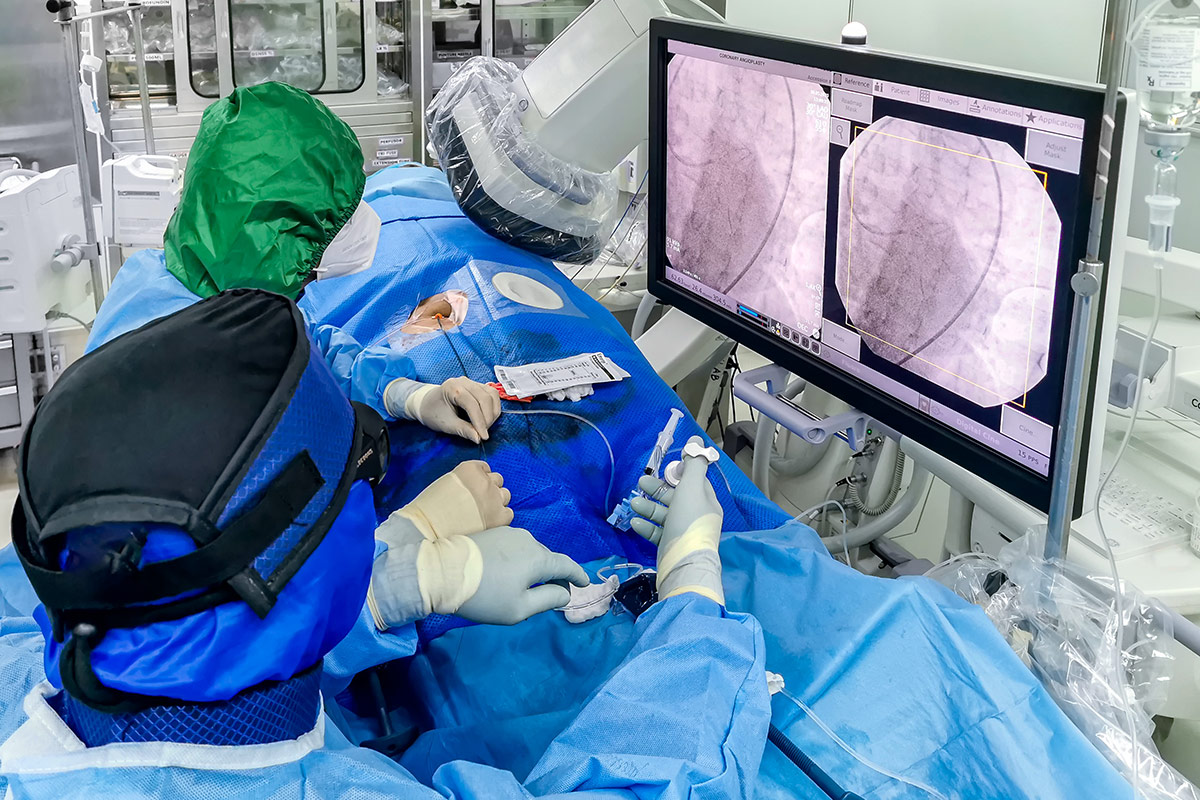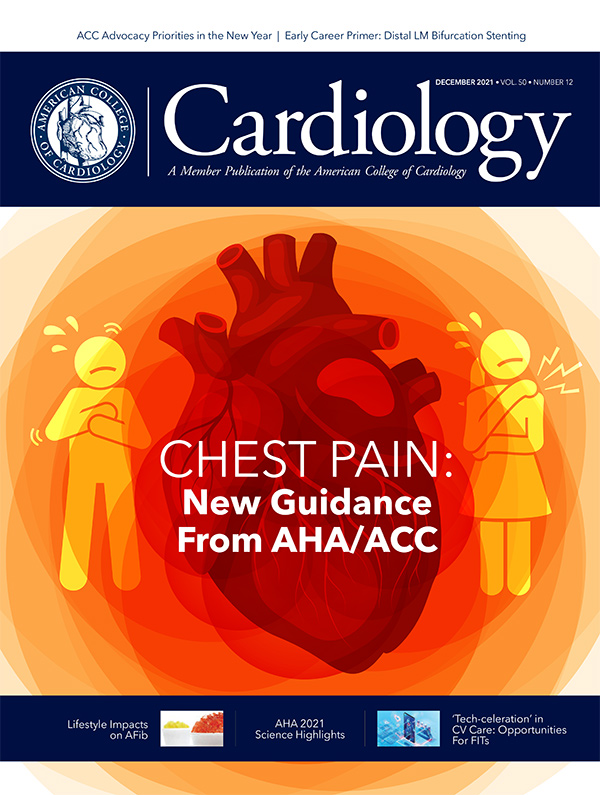Feature | Wrapping Up TCT 2021: My Interventional Takeaways

TCT 2021, a hybrid experience offering both virtual and in-person attendance in Orlando, as always provided top-notch science related to coronary and structural interventions. I'm delighted to share my top highlights and takeaways poised to affect practice.
Starting with the FAME III trial, which received the most attention during the meeting, PCI using current-generation drug-eluting stents (DES) and fractional flow reserve (FFR) guidance did not meet the criteria for noninferiority against CABG among patients with angiographic three-vessel disease. The findings are intriguing because the physiological assessment of the coronary lesions did not change the outcome of patients with multivessel coronary artery disease (CAD).
This is consistent with previous studies that showed better outcomes in patients with three-vessel disease who underwent CABG. The 10-year follow-up data from the SYNTAX trial have shown favorable outcomes in patients with three-vessel disease undergoing CABG compared with PCI, especially in patients with moderate and high SYNTAX scores (> 22). In the FAME III trial, a subgroup analysis showed there appears to be benefit with PCI among patients with low SYNTAX scores (0-22).
It was disappointing to see that less than 12% of the patients in the PCI group in FAME III had intravascular imaging. This likely had a significant impact on the PCI results, because imaging has been associated with a better outcome. Indeed, the ULTIMATE trial with IVUS-guided DES implantation significantly improved clinical outcome in all-comers, particularly for patients who had an IVUS-defined optimal procedure, compared with angiography guidance. Finally, based on the findings of the FAME III trial, I think there is no change in the current practice since patients with three-vessel disease, especially with intermediate or high SYNTAX scores, have better outcomes and survival with CABG compared with PCI.
Staying on physiological assessment of coronary arteries, the five-year outcomes from iFR-SWEDEHEART were also of interest. The goal of iFR-SWEDEHEART was to evaluate whether functional lesion assessment by instantaneous wave-free ratio (iFR) would be noninferior to FFR among patients with stable angina or acute coronary syndromes (ACS). The 12-month follow-up data, presented in 2017, showed that iFR was noninferior to FFR. At five years, iFR continues to be noninferior to FFR. Therefore, the preferential use of iFR over FFR for indeterminant lesions can be considered. The findings of iFR-SWEDEHEART are reassuring that there are no differences between the two modalities. However, it is also important to highlight the importance of always performing physiological assessment of intermediate lesions, which has been associated with better outcome in patients with stable and unstable acute coronary syndromes.
Also in the coronary space, it is known from the current guidelines that routine thrombectomy for coronary thrombus in the setting of ACS is harmful. This is mainly due to the increased risk of stroke based on previous studies. Findings from the CHEETAH clinical study demonstrated high rates of blood clot removal, blood flow restoration and myocardial perfusion in conjunction with PCI in patients with high thrombus burden using the Indigo System CAT RX Catheter continuous mechanical aspiration thrombectomy device. The single-arm study showed significant reduction in Thrombolysis in Myocardial Infarction (TIMI) thrombus grade, improved TIMI flow grade, and enhanced myocardial blush grade without device-related serious adverse events or stroke. Although CHEETAH is a single arm study with no control cohort, I believe that continuous mechanical aspiration is beneficial in providing ideal results with low risk. My expectation is to see a follow-up study comparing the current technology with conventional therapy to confirm these findings.
For structural interventions, the Amulet IDE trial showed the Amulet device was safe and effective at left atrial appendage (LAA) occlusion. It's very nice to see another LAA occluder device with favorable results, thereby providing our operators as well as patients more options.
Participants with nonvalvular atrial fibrillation who were not suitable for long-term anticoagulation were randomized to the Amulet device vs. the Watchman device. In this comparison, the Amulet device was effective at LAA occlusion, and it was superior to the Watchman device for achieving no/minimal residual leaks around the device. The Amulet device was noninferior to the Watchman device regarding safety and efficacy at 45 days. Superiority of closure with the Amulet device was sustained at 12 months. It is interesting to note that device-related thrombus was low with the Amulet device despite few participants being discharged on anticoagulation (21% in the Amulet group vs. 96% in the Watchman group).
More From TCT 2021
Click here for ACC's TCT Meeting Hub for complete coverage, including trial summaries, highlight videos and more.
The purpose of the SURTAVI trial was to assess the safety and efficacy of transcatheter aortic valve replacement (TAVR) with the self-expanding CoreValve compared with surgical AVR (SAVR) in intermediate-risk patients. The five-year follow-up presented at TCT 2021 showed that clinical outcomes were similar with both strategies. Paravalvular leak (PVL) rates were higher with TAVR and mean gradient was better compared with SAVR. There were more repeat valve interventions post TAVR (3.5% vs. 1.9%; p=0.02), which might be related to the durability of the valves used in the TAVR group. The findings of SURTAVI are important as we discuss options for patient with severe aortic valve stenosis who are intermediate surgical risk. As we see more iterations with better devices, it seems the need for re-intervention will be lower for patients undergoing TAVR procedures in the future.
The goal of the CHOICE-CLOSURE trial was to demonstrate the safety and efficacy of the MANTA vascular closure device (VCD) compared with the ProGlide VCD for access closure among patients undergoing transfemoral TAVR. The study showed there was a higher rate of major/minor vascular complications with the MANTA VCD compared with ProGlide VCD, despite a lower need for additional VCDs and shorter time to hemostasis with the ProGlide. The findings from CHOICE-CLOSURE clearly highlight safety concerns related to the MANTA VCD. However, operator experience is something we must keep in mind, as well as patient selection. In patients with no peripheral arterial disease, I believe the MANTA VCD continues to have a value and utility. Therefore, careful evaluation of preprocedural CT scanning of the peripheral vascular anatomy is critical and selecting the appropriate closure device for post large bore vascular access.

This article was authored by M. Chadi Alraies, MD, FACC, medical director of the cardiac catheterization laboratory and interventional cardiology research at Wayne State University/Detroit Medical Center in Michigan.
Clinical Topics: Acute Coronary Syndromes, Anticoagulation Management, Arrhythmias and Clinical EP, Cardiac Surgery, Cardiovascular Care Team, Invasive Cardiovascular Angiography and Intervention, Noninvasive Imaging, Stable Ischemic Heart Disease, Valvular Heart Disease, Atherosclerotic Disease (CAD/PAD), Anticoagulation Management and ACS, Anticoagulation Management and Atrial Fibrillation, Atrial Fibrillation/Supraventricular Arrhythmias, Aortic Surgery, Cardiac Surgery and Arrhythmias, Cardiac Surgery and SIHD, Cardiac Surgery and VHD, Interventions and ACS, Interventions and Coronary Artery Disease, Interventions and Imaging, Interventions and Structural Heart Disease, Angiography, Computed Tomography, Nuclear Imaging, Chronic Angina
Keywords: ACC Publications, Cardiology Magazine, Transcatheter Cardiovascular Therapeutics, TCT21, Follow-Up Studies, Drug-Eluting Stents, Fractional Flow Reserve, Myocardial, Atrial Fibrillation, Transcatheter Aortic Valve Replacement, Motivation, Coronary Artery Disease, Angina, Stable, Atrial Appendage, Vascular Closure Devices, Acute Coronary Syndrome, Patient Selection, Patient Discharge, Suction, Physician Executives, Percutaneous Coronary Intervention, Goals, Michigan, Universities, Thrombosis, Stroke, Thrombectomy, Aortic Valve Stenosis, Cardiology, Angiography, Infarction, Technology, Attention, Anticoagulants, Thrombolytic Therapy, Family Characteristics, Coronary Artery Bypass, Tomography, X-Ray Computed
< Back to Listings

